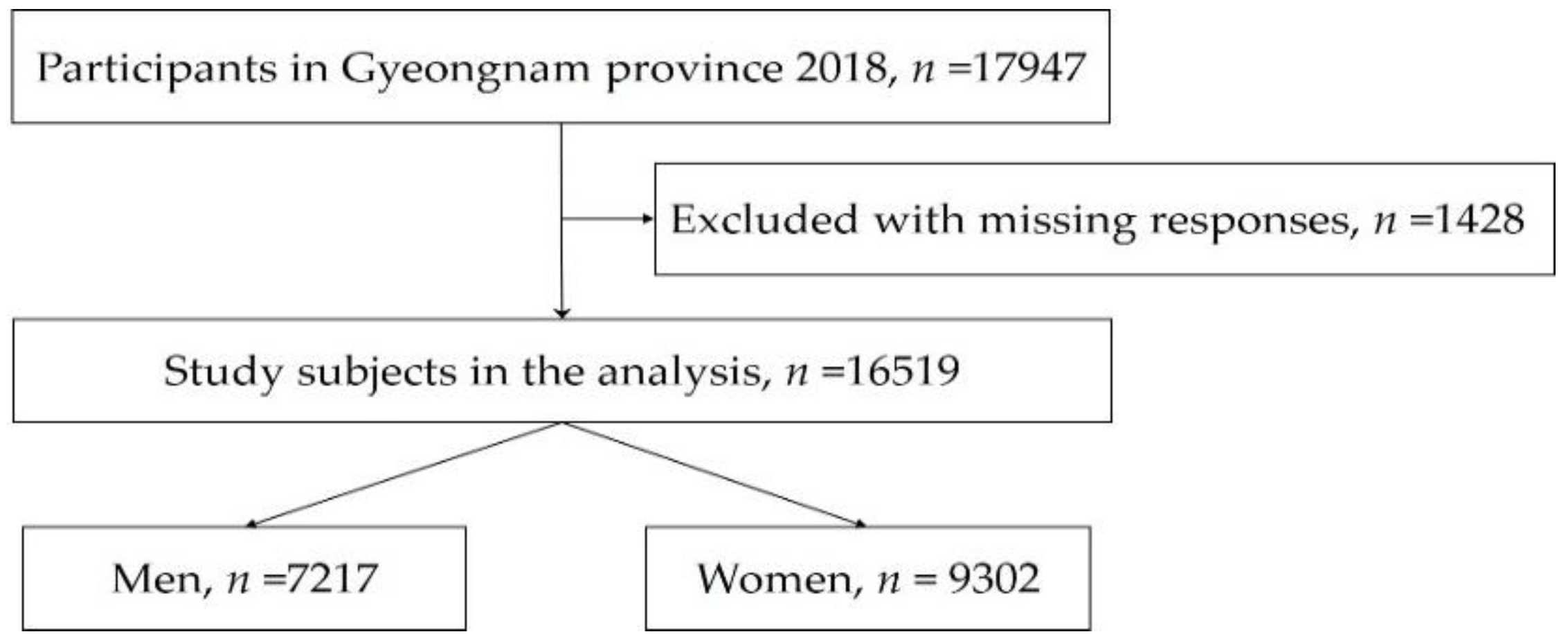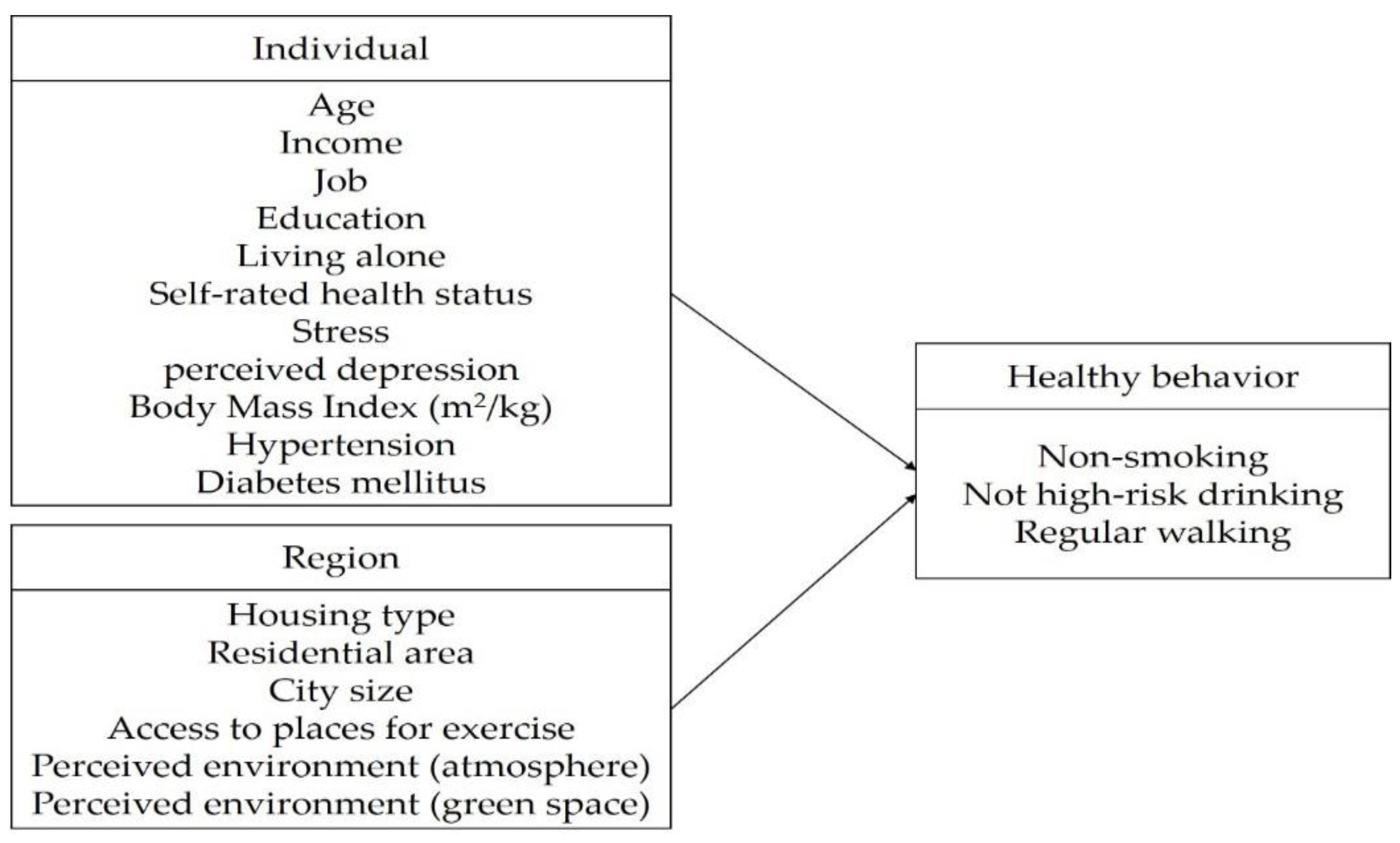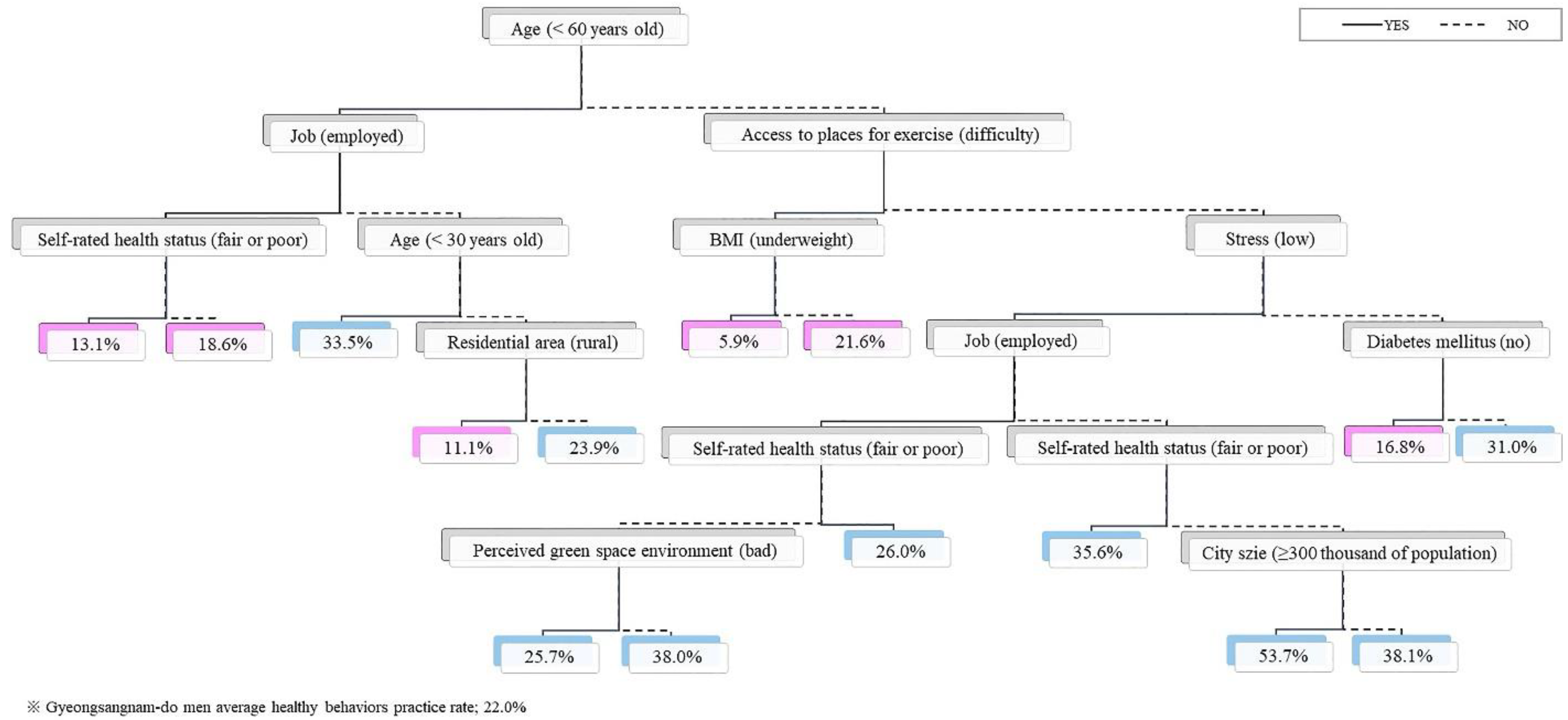Residential Characteristics as Factors Related to Healthy Behavior Practices—Decision Tree Model Analysis Using a Community Health Survey from Korea
Abstract
:1. Introduction
2. Materials and Methods
2.1. Subjects
Data Collection and Subjects
2.2. Materials
2.2.1. Dependent Variables
2.2.2. Variables Related to Healthy Behavior Practice
2.3. Statistical Analysis
3. Results
3.1. General Characteristics of the Subjects
3.2. Decision Tree Analysis Results
3.2.1. Results of the Decision Tree Analysis for Healthy Behavior Practices (Men)
3.2.2. Results of the Decision Tree Analysis for Healthy Behavior Practices (Women)
3.2.3. Importance of Factors Affecting Healthy Behavior Practices
4. Discussion
5. Conclusions
Author Contributions
Funding
Institutional Review Board Statement
Informed Consent Statement
Data Availability Statement
Conflicts of Interest
References
- World Health Organization. World Health Statistics 2018: Monitoring Health for the SDGs; World Health Organization: Geneva, Switzerland, 2018; p. 7. [Google Scholar]
- Lee, Y.; Kang, J.; Kim, J.; Nah, E.; Kim, Y.; Ko, K.; Kim, H. Clustering of Health Risk Behaviors for Chronic Diseases in Korean Adults. Korean J. Health Educ. Promot. 2017, 34, 21–31. [Google Scholar] [CrossRef]
- Meader, N.; King, K.; Wright, K.; Graham, H.M.; Petticrew, M.; Power, C.; White, M.; Sowden, A.J. Multiple Risk Behavior Interventions: Meta-Analyses of RCTs. Am. J. Prev. Med. 2017, 53, e19–e30. [Google Scholar] [CrossRef] [PubMed] [Green Version]
- Myint, P.K.; Luben, R.N.; Wareham, N.J.; Bingham, S.A.; Khaw, K. Combined Effect of Health Behaviours and Risk of First Ever Stroke in 20,040 Men and Women Over 11 Years’ Follow-Up in Norfolk Cohort of European Prospective Investigation of Cancer (EPIC Norfolk): Prospective Population Study. BMJ 2009, 338, b349. [Google Scholar] [CrossRef] [PubMed] [Green Version]
- Dorner, T.E.; Lackinger, C.; Haider, S.; Stein, K.V. Lifestyle Parameters in Patients with Diabetes Mellitus and in the General Adult Population—Trends Over Five Years: Results of the Austrian National Health Interview Series. Int. J. Environ. Res. Public Health 2021, 18, 9910. [Google Scholar] [CrossRef]
- Oftedal, S.; Kolt, G.S.; Holliday, E.G.; Stamatakis, E.; Vandelanotte, C.; Brown, W.J.; Duncan, M.J. Associations of Health-Behavior Patterns, Mental Health and Self-Rated Health. Prev. Med. 2019, 118, 295–303. [Google Scholar] [CrossRef] [Green Version]
- Krokstad, S.; Ding, D.; Grunseit, A.C.; Sund, E.R.; Holmen, T.L.; Rangul, V.; Bauman, A. Multiple Lifestyle Behaviours and Mortality, Findings from a Large Population-Based Norwegian Cohort Study-the HUNT Study. BMC Public Health 2017, 17, 58. [Google Scholar] [CrossRef] [Green Version]
- Ding, D.; Rogers, K.; van der Ploeg, H.; Stamatakis, E.; Bauman, A.E. Traditional and Emerging Lifestyle Risk Behaviors and all-Cause Mortality in Middle-Aged and Older Adults: Evidence from a Large Population-Based Australian Cohort. PLoS Med. 2015, 12, e1001917. [Google Scholar] [CrossRef]
- Loef, M.; Walach, H. The Combined Effects of Healthy Lifestyle Behaviors on all Cause Mortality: A Systematic Review and Meta-Analysis. Prev. Med. 2012, 55, 163–170. [Google Scholar] [CrossRef]
- Meader, N.; King, K.; Moe-Byrne, T.; Wright, K.; Graham, H.; Petticrew, M.; Power, C.; White, M.; Sowden, A.J. A Systematic Review on the Clustering and Co-Occurrence of Multiple Risk Behaviours. BMC Public Health 2016, 16, 657. [Google Scholar] [CrossRef] [Green Version]
- Noble, N.; Paul, C.; Turon, H.; Oldmeadow, C. Which Modifiable Health Risk Behaviours are Related? A Systematic Review of the Clustering of Smoking, Nutrition, Alcohol and Physical Activity (‘SNAP’) Health Risk Factors. Prev. Med. 2015, 81, 16–41. [Google Scholar] [CrossRef]
- Prendergast, K.B.; Mackay, L.M.; Schofield, G.M. The Clustering of Lifestyle Behaviours in New Zealand and their Relationship with Optimal Wellbeing. Int. J. Behav. Med. 2016, 23, 571–579. [Google Scholar] [CrossRef] [PubMed]
- Conry, M.C.; Morgan, K.; Curry, P.; McGee, H.; Harrington, J.; Ward, M.; Shelley, E. The Clustering of Health Behaviours in Ireland and their Relationship with Mental Health, Self-Rated Health and Quality of Life. BMC Public Health 2011, 11, 692. [Google Scholar] [CrossRef] [PubMed]
- James, E.; Freund, M.; Booth, A.; Duncan, M.J.; Johnson, N.; Short, C.E.; Wolfenden, L.; Stacey, F.G.; Kay-Lambkin, F.; Vandelanotte, C. Comparative Efficacy of Simultaneous Versus Sequential Multiple Health Behavior Change Interventions among Adults: A Systematic Review of Randomised Trials. Prev. Med. 2016, 89, 211–223. [Google Scholar] [CrossRef] [PubMed]
- Lippke, S.; Nigg, C.R.; Maddock, J.E. Health-Promoting and Health-Risk Behaviors: Theory-Driven Analyses of Multiple Health Behavior Change in Three International Samples. Int. J. Behav. Med. 2012, 19, 1–13. [Google Scholar] [CrossRef] [PubMed] [Green Version]
- Brieman, L.; Friedman, J.H.; Olshen, R.A.; Stone, C.J. Classification and Regression Trees; Wadsworth Inc.: Perrysburg, OH, USA, 1984; p. 67. [Google Scholar]
- Yoo, G.M.; Jin, S.; Moon, S.H. Exploratory Study on Factors of Unmet Medical Needs using Data Mining Analysis. Korean Policy Stud. Rev. 2016, 25, 269–300. [Google Scholar]
- Lee, D.W.; Moon, S.H.; Lee, H.J.; Lee, S.D. Data Mining Analysis of Factors to Predict the Suicidal Risk of the Elderly. Korean Policy Stud. Rev. 2016, 25, 297–329. [Google Scholar]
- Kim, H.; Choi, K.; Lim, S.; Rhee, H. Development of Prediction Model for Prevalence of Metabolic Syndrome using Data Mining: Korea National Health and Nutrition Examination Study. J. Digit. Converg. 2016, 14, 325–332. [Google Scholar] [CrossRef] [Green Version]
- Kang, S.; Choi, S. Group Classification on Management Behavior of Diabetic Mellitus. J. Korea Acad. Ind. Coop. Soc. 2011, 12, 765–774. [Google Scholar]
- Kang, Y.W.; Ko, Y.S.; Kim, Y.J.; Sung, K.M.; Kim, H.J.; Choi, H.Y.; Sung, C.; Jeong, E. Korea Community Health Survey Data Profiles. Osong Public Health Res. Perspect. 2015, 6, 211–217. [Google Scholar] [CrossRef] [Green Version]
- Toselli, S.; Bragonzoni, L.; Dallolio, L.; Alessia, G.; Masini, A.; Marini, S.; Barone, G.; Pinelli, E.; Zinno, R.; Mauro, M. The Effects of Park Based Interventions on Health: The Italian Project “Moving Parks”. Int. J. Environ. Res. Public Health 2022, 19, 2130. [Google Scholar] [CrossRef]
- Mytton, O.T.; Townsend, N.; Rutter, H.; Foster, C. Green Space and Physical Activity: An Observational Study using Health Survey for England Data. Health Place 2012, 18, 1034–1041. [Google Scholar] [CrossRef] [PubMed] [Green Version]
- Wang, H.; Dai, X.; Wu, J.; Wu, X.; Nie, X. Influence of Urban Green Open Space on Residents’ Physical Activity in China. BMC Public Health 2019, 19, 1–12. [Google Scholar] [CrossRef] [PubMed] [Green Version]
- Liu, Q.; Yamada, T.; Liu, H.; Lin, L.; Fang, Q. Healthy Behavior and Environmental Behavior Correlate with Bicycle Commuting. Int. J. Environ. Res. Public Health 2022, 19, 3318. [Google Scholar] [CrossRef] [PubMed]
- Akpinar, A.; Cankurt, M. How are Characteristics of Urban Green Space Related to Levels of Physical Activity: Examining the Links. Indoor Built Environ. 2017, 26, 1091–1101. [Google Scholar] [CrossRef]
- Kothencz, G.; Kolcsár, R.; Cabrera-Barona, P.; Szilassi, P. Urban Green Space Perception and its Contribution to Well-Being. Int. J. Environ. Res. Public Health 2017, 14, 766. [Google Scholar] [CrossRef] [PubMed] [Green Version]
- Derose, K.P.; Wallace, D.D.; Han, B.; Cohen, D.A. Effects of Park-Based Interventions on Health-Related Outcomes: A Systematic Review. Prev. Med. 2021, 147, 106528. [Google Scholar] [CrossRef]
- Wallace, D.D.; Derose, K.P.; Han, B.; Cohen, D.A. The Effects of Park-Based Interventions on Health: A Systematic Review Protocol. Syst. Rev. 2020, 9, 135. [Google Scholar] [CrossRef]
- Barnett, D.W.; Barnett, A.; Nathan, A.; Van Cauwenberg, J.; Cerin, E. Built Environmental Correlates of Older Adults’ Total Physical Activity and Walking: A Systematic Review and Meta-Analysis. Int. J. Behav. Nutr. Phys. Act. 2017, 14, 103. [Google Scholar] [CrossRef] [Green Version]
- Kim, J. The Relationships between Perceived Neighborhood Characteristics and Self-Rated Health Or Depression: The Interaction Effects with Sociodemographic Variables. Health Soc. Welf. Rev. 2018, 38, 290–315. [Google Scholar]
- Kang, H.S.; Lee, S.Y. The Relationship among Subjective Health Status, Social Support and Health Promoting Behavior. J. Korea Soc. Wellness 2017, 12, 413–421. [Google Scholar] [CrossRef]
- Lee, M.J.; Kown, D.H.; Kim, Y.Y.; Kim, J.H.; Moon, S.J.; Park, K.W.; Park, I.W.; Park, J.Y.; Baek, N.Y.; Son, G.S. Factors Associated with Experience of Diagnosis and Utilization of Chronic Diseases among Korean Elderly: Focus on Comparing between Urban and Rural Elderly. J. Agric. Med. Community Health 2019, 44, 165–184. [Google Scholar]
- Hwang, S.; Park, J.; Lee, H.; Kim, E. A Study on Health Promotion Behaviors of a Group of Middle Aged Men in K-Ku, Incheon City. J. Korean Acad. Community Health Nurs. 2004, 15, 408–418. [Google Scholar]
- Lee, M.; Park, S.; Lee, K. Relationship between Morbidity and Health Behavior in Chronic Diseases. J. Clin. Med. 2020, 9, 121. [Google Scholar] [CrossRef] [PubMed] [Green Version]
- Zhao, C.; Wong, L.; Zhu, Q.; Yang, H. Prevalence and Correlates of Chronic Diseases in an Elderly Population: A Community-Based Survey in Haikou. PLoS ONE 2018, 13, e0199006. [Google Scholar] [CrossRef] [PubMed] [Green Version]
- Strong, K.; Mathers, C.; Leeder, S.; Beaglehole, R. Preventing Chronic Diseases: How Many Lives can we Save? The Lancet 2005, 366, 1578–1582. [Google Scholar] [CrossRef]
- Choi, M.J.; Kwon, J.H. Social Exclusion and Income Inequality of the Rural Elderly. Discourse Policy Soc. Sci. 2014, 7, 103–138. [Google Scholar]
- Ross, C.E.; Mirowsky, J. Sex Differences in the Effect of Education on Depression: Resource Multiplication or Resource Substitution? Soc. Sci. Med. 2006, 63, 1400–1413. [Google Scholar] [CrossRef]
- Michie, S.; Van Stralen, M.M.; West, R. The Behaviour Change Wheel: A New Method for Characterising and Designing Behaviour Change Interventions. Implement. Sci. 2011, 6, 42. [Google Scholar] [CrossRef] [Green Version]
- Hutchinson, J.; Prady, S.L.; Smith, M.A.; White, P.C.; Graham, H.M. A Scoping Review of Observational Studies Examining Relationships between Environmental Behaviors and Health Behaviors. Int. J. Environ. Res. Public Health 2015, 12, 4833–4858. [Google Scholar] [CrossRef]
- Thomas, K.; Nilsson, E.; Festin, K.; Henriksson, P.; Lowén, M.; Löf, M.; Kristenson, M. Associations of Psychosocial Factors with Multiple Health Behaviors: A Population-Based Study of Middle-Aged Men and Women. Int. J. Environ. Res. Public Health 2020, 17, 1239. [Google Scholar] [CrossRef] [Green Version]
- Heo, H.H. A Community-Based Participatory Approach to Reducing Health Inequalities. In Health Welfare Policy Forum; KIHASA: Sejong, Korea, 2018; p. 62. [Google Scholar] [CrossRef]
- Lee, J.H. The Regional Health Inequity, and Individual and Neighborhood Level Health Determinants. Health Soc. Welf. Rev. 2016, 36, 345–384. [Google Scholar]
- Park, J.W. Socioeconomic Inequalities in Health at the Regional Level in Korea. Korea Inst. Health Soc. Aff. 2018, 260, 7–19. [Google Scholar] [CrossRef]
- Lee, J.; Kwon, K.; Lee, J.; Jeon, G. A Study on Health Behavior of the Populations in Urban and Rural Area. J. Agric. Med. Community Health 2005, 30, 213–225. [Google Scholar]
- Durazo, E.; Jones, M.; Wallace, S.; Van Arsdale, J.; Aydin, M.; Stewart, C. The Health Status and Unique Health Challenges or Rural Older Adults in California. 2011. Available online: https://escholarship.org/content/qt0ds8j0w9/qt0ds8j0w9.pdf?t=lms9ye (accessed on 25 April 2022).
- Kim, K.; Eun, S.J. Classification of Clusters, Characteristics and Related Factors According to Drinking, Smoking, Exercising and Nutrition among Korean Adults. J. Korea Acad. -Ind. Coop. Soc. 2019, 20, 252–266. [Google Scholar]
- Noh, J.; Kim, K.; Cheon, J.; Lee, Y.; Yoo, K. Factors Associated with Single-use and Co-use of Tobacco and Alcohol: A Multinomial Modeling Approach. Int. J. Environ. Res. Public Health 2019, 16, 3506. [Google Scholar] [CrossRef] [Green Version]
- Kim, E.; Choo, I.; Noh, Y. Factors Influencing the Practice of Healthy Living as an Integrated Indicator of the Elderly’s Drinking, Smoking, and Walking Patterns: Using Korea Community Health Surveys. Int. J. Environ. Res. Public Health 2022, 19, 1936. [Google Scholar] [CrossRef]
- Lee, S.; Kim, K.; Lee, D.; Hong, N. Participation in the Gyeongsangbuk-do Health Saemaeul Program and Health Behavior Improvement Effect. J. Health Inform. Stat. 2019, 44, 384–393. [Google Scholar] [CrossRef] [Green Version]




| Characteristics | Total (n = 16,519) | Men (n = 7217) | Women (n = 9302) | p-Value | ||
|---|---|---|---|---|---|---|
| Demographic | Age | 19–29 | 1182 (7.2) | 613 (8.5) | 569 (6.1) | <0.001 |
| 30–39 | 1758 (10.6) | 801 (11.1) | 957 (10.3) | |||
| 40–49 | 2537 (15.4) | 1209 (16.8) | 1328 (14.3) | |||
| 50–59 | 3157 (19.1) | 1450 (20.1) | 1707 (18.4) | |||
| 60–69 | 3423 (20.7) | 1503 (20.8) | 1920 (20.6) | |||
| ≥70 | 4462 (27.0) | 1641 (22.7) | 2821 (30.3) | |||
| Income 1 | <KRW 2.0 million | 6848 (41.5) | 2564 (35.5) | 4284 (46.1) | <0.001 | |
| ≥KRW 2.0 million | 9671 (58.5) | 4653 (64.5) | 5018 (53.9) | |||
| Job | Unemployed | 6544 (39.6) | 1921 (26.6) | 4623 (49.7) | <0.001 | |
| Employed | 9975 (60.4) | 5296 (73.4) | 4679 (50.3) | |||
| Education | ≤Middle school | 5255 (31.8) | 1403 (19.4) | 3852 (41.4) | <0.001 | |
| ≥High school | 11,264 (68.2) | 5814 (80.6) | 5450 (58.6) | |||
| Marital status | Living alone | 5344 (32.4) | 1740 (24.1) | 3604 (38.7) | <0.001 | |
| married | 11,175 (67.6) | 5477 (75.9) | 5698 (61.3) | |||
| Health-related | Self-rated health status | Fair or poor | 11,447 (69.3) | 4597 (63.7) | 6850 (73.6) | <0.001 |
| Good | 5072 (30.7) | 2620 (36.3) | 2452 (26.4) | |||
| Stress | Low | 13,148 (79.6) | 5881 (81.5) | 7267 (78.1) | <0.001 | |
| High | 3371 (20.4) | 1336 (18.5) | 2035 (21.9) | |||
| Perceived depression | No | 15,696 (95.0) | 6981 (96.7) | 8715 (93.7) | <0.001 | |
| Yes | 823 (5.0) | 236 (3.3) | 587 (6.3) | |||
| Body Mass Index (m2/kg) | Underweight | 642 (3.9) | 239 (3.3) | 403 (4.3) | <0.001 | |
| Normal | 10,117 (61.2) | 4196 (58.1) | 5921 (63.7) | |||
| Obesity | 5760 (34.9) | 2782 (38.5) | 2978 (32.0) | |||
| Hypertension | No | 11,673 (70.7) | 5343 (74.0) | 6330 (68.0) | <0.001 | |
| Yes | 4846 (29.3) | 1874 (26.0) | 2972 (32.0) | |||
| Diabetes mellitus | No | 14,665 (88.8) | 6396 (88.6) | 8269 (88.9) | 0.584 | |
| Yes | 1854 (11.2) | 821 (11.4) | 1033 (11.1) | |||
| Region | Housing type | House | 11,079 (67.1) | 4764 (66.0) | 6315 (67.9) | 0.011 |
| Apartment | 5440 (32.9) | 2453 (34.0) | 2987 (32.1) | |||
| Residential area 2 | Urban | 5757 (34.9) | 2564 (35.5) | 3193 (34.3) | 0.108 | |
| Rural | 10,762 (65.1) | 4653 (64.5) | 6109 (65.7) | |||
| City size 3 | City 1 | 5062 (30.6) | 2259 (31.3) | 2803 (30.1) | 0.053 | |
| City 2 | 3386 (20.5) | 1514 (21.0) | 1872 (20.1) | |||
| City 3 | 3280 (19.9) | 1422 (19.7) | 1858 (20.0) | |||
| City 4 | 4791 (29.0) | 2022 (28.0) | 2769 (29.8) | |||
| Access to places for exercise | Difficulty | 4149 (25.1) | 1741 (24.1) | 2408 (25.9) | 0.010 | |
| Easy | 12,370 (74.9) | 5476 (75.9) | 6894 (74.1) | |||
| Perceived environment (atmosphere) | Bad | 5520 (33.4) | 2397 (33.2) | 3123 (33.6) | 0.626 | |
| Good | 10,999 (66.6) | 4820 (66.8) | 6179 (66.4) | |||
| Perceived environment (green space) | Bad | 4886 (29.6) | 2119 (29.4) | 2767 (29.7) | 0.591 | |
| Good | 11,633 (70.4) | 5098 (70.6) | 6535 (70.3) | |||
| Healthy behavior 4 | No | 11,703 (70.8) | 5629 (78.0) | 6074 (65.3) | <0.001 | |
| Yes | 4816 (29.2) | 1588 (22.0) | 3228 (34.7) | |||
| Smoking status | No | 13,824 (83.7) | 4761 (66.0) | 9063 (97.4) | <0.001 | |
| Yes | 2695 (16.3) | 2456 (34.0) | 239 (2.6) | |||
| High-risk drinking 5 | No | 14,850 (89.9) | 5548 (76.9) | 9302 (100) | <0.001 | |
| Yes | 1669 (10.1) | 1669 (23.1) | 0 (0.0) | |||
| Regular walking 6 | No | 10,519 (63.7) | 4513 (62.5) | 6006 (64.6) | 0.007 | |
| Yes | 5999 (36.3) | 2704 (37.5) | 3295 (35.4) | |||
| Total | 16,519 (100.0) | 7217 (43.7) | 9302 (56.3) | |||
| Variables | Importance | |
|---|---|---|
| Men | Age | 0.46 |
| Job | 0.15 | |
| Access to places for exercise | 0.13 | |
| Self-rated health status | 0.11 | |
| Stress | 0.07 | |
| City size 1 | 0.02 | |
| Body Mass Index | 0.02 | |
| Residential area | 0.02 | |
| Diabetes mellitus | 0.02 | |
| Perceived environment (green space) | 0.01 | |
| Women | Access to places to exercise | 0.33 |
| Age | 0.28 | |
| Job | 0.08 | |
| Self-rated health status | 0.07 | |
| Living alone | 0.07 | |
| City size 2 | 0.07 | |
| Housing type | 0.04 | |
| Education | 0.03 | |
| Hypertension | 0.03 |
Publisher’s Note: MDPI stays neutral with regard to jurisdictional claims in published maps and institutional affiliations. |
© 2022 by the authors. Licensee MDPI, Basel, Switzerland. This article is an open access article distributed under the terms and conditions of the Creative Commons Attribution (CC BY) license (https://creativecommons.org/licenses/by/4.0/).
Share and Cite
Seo, A.-R.; Park, K.-S. Residential Characteristics as Factors Related to Healthy Behavior Practices—Decision Tree Model Analysis Using a Community Health Survey from Korea. Int. J. Environ. Res. Public Health 2022, 19, 7390. https://doi.org/10.3390/ijerph19127390
Seo A-R, Park K-S. Residential Characteristics as Factors Related to Healthy Behavior Practices—Decision Tree Model Analysis Using a Community Health Survey from Korea. International Journal of Environmental Research and Public Health. 2022; 19(12):7390. https://doi.org/10.3390/ijerph19127390
Chicago/Turabian StyleSeo, Ae-Rim, and Ki-Soo Park. 2022. "Residential Characteristics as Factors Related to Healthy Behavior Practices—Decision Tree Model Analysis Using a Community Health Survey from Korea" International Journal of Environmental Research and Public Health 19, no. 12: 7390. https://doi.org/10.3390/ijerph19127390







